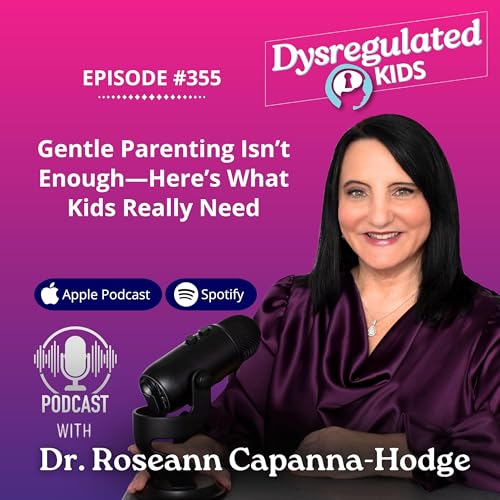
355: Gentle Parenting Isn’t Enough—Here’s What Kids Really Need
No se pudo agregar al carrito
Add to Cart failed.
Error al Agregar a Lista de Deseos.
Error al eliminar de la lista de deseos.
Error al añadir a tu biblioteca
Error al seguir el podcast
Error al dejar de seguir el podcast
-
Narrado por:
-
De:
Parenting a child who constantly melts down—even when you’ve tried every gentle parenting tip out there—can leave you exhausted and doubting yourself.
You’re doing your best to be calm and validating, yet you still feel like you’re walking on eggshells. You’re not alone. The truth is, gentle parenting isn’t enough on its own—and understanding whycan completely change your family dynamic.
Let’s break down what gentle parenting gets right, what it misses, and how to help your child truly regulate and thrive. Learn more about why empathy without boundaries backfires, what “Regulate, Connect, Correct” really means, and how to shift from over-validation to true emotional safety.
Why Doesn’t Gentle Parenting Always Work?Gentle parenting promotes empathy, validation, and connection instead of harsh punishment. That’s beautiful in theory—but many parents discover it’s not enough in real life.
Here’s why: Validation alone doesn’t calm a dysregulated brain.
- Kids may feel heard, but not necessarily safe.
- A dysregulated nervous system can’t learn, connect, or cooperate.
- Empathy without boundaries often fuels anxiety and chaos.
When kids stay stuck in big emotions, they become dependent on constant reassurance instead of learning self-regulation. That’s when parents start feeling drained and walking on eggshells.
🗣️ “Gentle parenting only works when it’s built on regulation first.” –Dr. Roseann
What Happens When We Over-Validate Our Kids’ Emotions?Many parents think if they just validate enough, their child will calm down. But over-validation can actually make things worse.
I worked with a mom named Missy and her daughter, Emma. Missy tried so hard to ease Emma’s worries that she validated every fear—“We’ll get there on time,” “It’ll be okay,” “You don’t need to worry.”
But over time, Emma started needing constant reassurance just to feel calm. Her worries grew bigger, not smaller, and she began spiraling into obsessive thinking that bordered on compulsive behavior.
- Over-validation = more anxiety, not less.
- Kids learn emotions dominate, instead of learning to manage them.
- They need boundaries and co-regulation to feel truly safe.
The truth? Validation without tools or limits can create dependence. Boundaries are what anchor a child’s nervous system and reduce anxiety.
Yelling less and staying calm isn’t about being perfect—it’s about having the right tools.
Join the Dysregulation Insider VIP list and get your FREE Regulation Rescue Kit, designed to help you handle oppositional behaviors without losing it.
Download it now at www.drroseann.com/newsletter
How Do I Regulate First When I’m the One Who’s Overwhelmed?Parenting a dysregulated child while you’re dysregulated too is a recipe for chaos. That’s why “Regulate First Parenting” starts with you.
Before reacting or rescuing, pause and breathe. That pause resets both your brain and your child’s.
Try this:
- Pause before you validate.
- Don’t rescue too fast.
- Set a calm, clear boundary.
Your calm becomes your child’s calm. This is co-regulation in action—the process of letting your child “borrow” your steadiness. When


